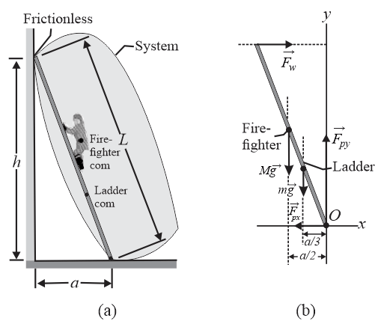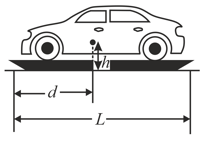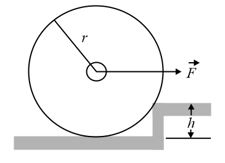In the figure shown below, trying to get his car out of mud, a man ties one end of a rope around the front bumper and the other end tightly around a utility pole away. He then pushes sideways on the rope at its midpoint with a force of , displacing the center of the rope but the car barely moves. What is the magnitude of the force on the car from the rope? (The rope stretches somewhat.)



Important Questions on Equilibrium and Elasticity
In the figure shown below and the associated sample problem, let the coefficient of static friction between the ladder and the pavement be . How far (in percent) up the ladder must the firefighter go to put the ladder on the verge of sliding?

In the figure shown below, the driver of a car on a horizontal road makes an emergency stop by applying the brakes, so that all four wheels lock and skid along the road. The coefficient of kinetic friction between the tyres and the road is . The separation between the front and the rear axles is and the centre of mass of the car is located at distance behind the front axle and distance above the road. The car weighs . Find the magnitude of (a) the braking acceleration of the car, (b) the normal force on each rear wheel, (c) the normal force on each front wheel, (d) the braking force on each rear wheel and (e) the braking force on each front wheel. (Hint: Although the car is not in translational equilibrium, it is in rotational equilibrium.)

In the figure shown below, what magnitude of (constant) force applied horizontally at the axle of the wheel, necessary to raise the wheel over a step obstacle of height, ? The wheel's radius is and its mass is

Figure shows a vertical uniform beam of length that is hinged at its lower end. A horizontal force is applied to the beam at distance from the lower end. The beam remains vertical because of a cable attached at the upper end, at angle with the horizontal. Figure gives the tension in the cable as a function of the position of the applied force, given as a fraction of the beam length. The scale of the axis is set by . Figure gives the magnitude of the horizontal force on the beam from the hinge, also as a function of . Evaluate angle and the magnitude of .

Figure shows the anatomical structures in the lower leg and foot that are involved in standing on tiptoe on one foot, with the heel raised slightly off the floor, so that the foot effectively contacts the floor only at point . Assume the distance , distance and the person's weight . Of the forces acting on the foot, what are the magnitude and direction (up or down) of the force at point from the calf muscle and the magnitude and direction (up or down) of the force at point from the lower leg bones? By how much is that force reduced if the person loses of mass?

Figure below shows the stress-strain curve for a material. The scale of the stress axis is set by , in units of . What are (a) the Young's modulus and (b) the approximate yield strength for this material?

